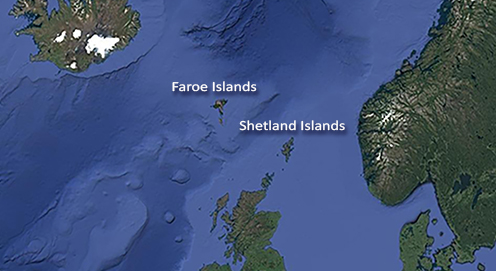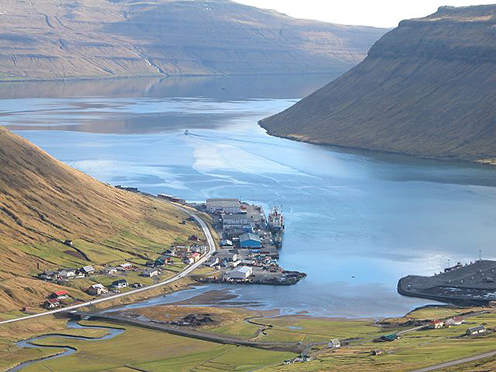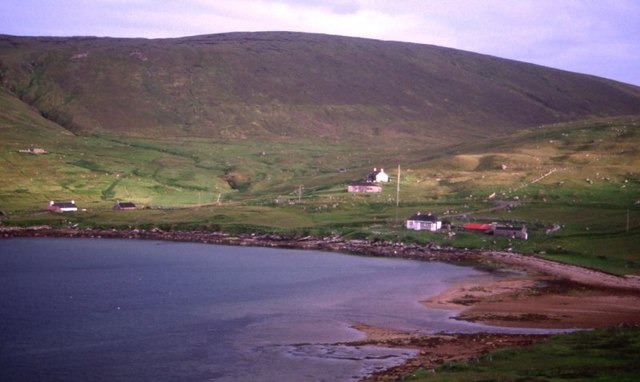Kollafjørður and Collafirth – one name, many places
Far out in the North Atlantic there are two groups of green islands: the Shetland islands, which today form a part of Great Britain, and the Faroe Islands, which now form a part of the Danish federation of states. Beneath the surface they have more in common than one might think.

Although there are traces of human habitation in the Shetland islands that go back as far as 5,000 years, it is the settlement of Scandinavians there in the eighth century that has been of crucial significance for the later history of the islands – reflected in particular in the language and its place-names. From the year 875 the Shetland islands, then known as Hjaltland, belonged under Norway as an earldom. Later, together with the rest of Norway, they came under the same king as Denmark in 1380, when Håkon VI died and his son with Margrethe I, Oluf, became king of both Norway and Denmark.
In 1469 the island group was mortgaged as surety for the bride's dowry on the occasion of the marriage between Christian I's daughter Margrethe with the future Scottish king, James III. Since Denmark never redeemed the loan, he finally surrendered the Shetland islands to Scotland in 1590. After the English-Scottish union was established in 1707, the island-group has thus formed a part of the United Kingdom (UK).
In the Faroes the oldest archaeological finds pointing to permanent residence there date from the second half of the 9th century – probably a colony of West Norwegian settlers who dislodged the Irish monks who had first come to the Faroes in the 7th century. Just like the Shetland islands the Faroe islands belonged under Norway until 1380, where they came to share the same Danish king. Thus the Faroe islands both linguistically and culturally have formed part of the Scandinavian fellowship for about 1.200 years in spite of their isolated North Atlantic situation, while the Scandinavian influence on the Shetland islands was limited to approximately one thousand years .
Shared fate and name
The much-travelled Scandinavians in the Viking period have left their mark on both island-groups. The Faroes still present today an overriding Nordic impression and on the Shetland islands it is in spite of more than 300 years under British rule possible to recognise a strong Nordic quality in their language, culture and place-names. And it is just this Nordic influence on the place-names corpora of the islands that makes it clear to see that there was more than just their isolated position in the North Atlantic that links the Faroes and Shetland. There is a common historical destiny, particularly obvious in the place-names that are found in both the island groups – in both form and meaning.
Thus for example we can find on the Faroese island Streymoy a settlement with the name Kollafjørður, while an anglicized variant of the same place-name occurs at several places in the Shetland islands in the form Collafirth.
The earliest occurrence of the Faroese Kollafjørður is found together with 33 other settlements in the manuscript Hundabrævið (The dog letter), written in 1350 and 1400 in the form kola firdi. While the name itself may well be much older, it is not found in either of the two oldest sources for the history of the Faroes, Seyðarbrævið (The sheep letter) from 1298 or Føroyinga søga (Saga of the Faroese), which was written in Iceland in the 13th century.
The Shetland Collafirth was first recorded rather later, in 1507 on the peninsula of Northmaven in the form Collafyrtht, while the name is also found in reciprocated versions as North Collafirth and South Collafirth, and in 1576-1716 in the Delting region in the form Colafirth.
The settlement at the fiord with the hilltops
The two Faroese linguists Jakob Jakobsen and Eivind Weyhe both interpret the Faroese settlement-name Kollafjørður as 'the rounded hilltops at the fiord'. The first element is the genitive plural of the noun kollr, in the Old Norse form kollr 'round-topped: with round top' and the second element is the noun fjørður 'fiord'. Both scholars consider it obvious that the settlement-name was originally the name of the fiord, a name that is most likely to be interpreted as 'the fiord with the rounded mountain tops'.

In the Shetland islands Jakob Jakobsen also interpreted the first element in Collafirth as 'a hill with round top, properly the upper rounding of the head', while the Shetland-Scots name scholar John Stewart similarly, but being a man of few words, interpreted the first element of Collafirth as 'round hill'. The second element is also interpreted by Jakob Jakobson as 'a firth, bay' but in present English this would be 'fjord' or 'fiord'. Generally the older Nordic form fjǫrðr in Shetland names has in the course of time been replaced by the English form with the same meaning: firth 'a narrow inlet of the sea, an estuary'.

Many Nordic colls
There can be no doubt that the Scandinavian seafarers did not only take human beings and wealth with them between the various lands and areas where they settled down but also both their language and culture – including names and naming customs. In this way they have left an impression that can still be clearly seen to this very day, even though the places in question have changed their national affiliations several times. If one looks further out in the Nordic area, we can also find in Iceland a version of Kollafjørður/Collafirth in the form Kollafjörður with the same natural historical interpretation, while in Denmark there are several examples of the old noun kold 'round hill' employed as first element in place-names, including in Kollerød and Kollerup.
The place-name Kollerup is particularly frequently employed in Denmark but in two of the cases Bent Jørgensen in Danske stednavne proposes two possible suggestions for interpretation of the first element: either kold corresponding to the Faroese and Shetland noun '(internal) round hill' or the divergent version of the Old Danish masculine name Kolli. Funnily enough Jakob Jakobsen also mentions the possibility of interpreting the first element as a masculine name in the Faroese Kollafjørður, where there is a legend about a man called Kolli, who is said to have established the settlement in olden times.
Caroline Høgland Valentin Boolsen
Contact
 Caroline Høglund Valentin Boolsen wrote her thesis on Scandinavian place-names in Yorkshire at the Department of Nordic Studies and Linguistics
Caroline Høglund Valentin Boolsen wrote her thesis on Scandinavian place-names in Yorkshire at the Department of Nordic Studies and Linguistics
Literature
- Den Store Danske on the Shetland Islands (in Danish)
- Den Store Danske on the history of the Faroe Islands (in Danish)
- Jakobsen, Jakob. 1897. The Dialect and Place Names of Shetland: Two Popular Lectures. N.p. Lerwick.
- Jakobsen, Jakob. 1909. Strejflys over færøske stednavne. Festskrift til Ludvig F.A. Wimmer. Oldnordisk tidsskrift for filologi. København.
- Jakobsen, Jakob. 1957. Greinir og ritgerðir. Forord: Chr. Matras. Red.: John Davidsen. Tórshavn. [Genoptryk af Jakobsen 1909].
- Jakobsen, Jakob. 1993. The Place-Names of Shetland. Reprint. [Shetland Library]. Lerwick.
- Jørgensen, Bent. 2008. Danske stednavne. 3. udgave. Gyldendal. København.
- Stewart, John. 1987. Shetland Place-Names. Hillhead: Shetland Library and Museum.
- Weyhe, Eivind. Kollafjørður, Í Kollafirði. Ikke udgivet tekst.
- Zachariasen, Ulf. 1984. Nogle nordatlantiske stednavneparalleller. I: Namn och Bygd: tidskrift för nordisk ortnamnsforskning. Årg. 72. Akademiska Bokhandeln. Uppsala.
